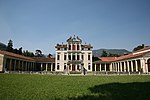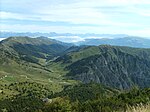Ponte Vecchio, Bassano
Bridges in VenetoBuildings and structures in the Province of VicenzaCovered bridges in ItalyPontoon bridgesWooden bridges in Italy

The Ponte Vecchio (Old bridge) or Ponte degli Alpini (bridge of the Alpini, who rebuilt it in 1948) is the covered wooden designed by the architect Andrea Palladio in 1569. The bridge is located in Bassano del Grappa and was destroyed many times, the last time in World War II. The bridge spans the river Brenta. The Brenta was an important means of communication in the 18th century from the mountains of Grappa to Venice.
Excerpt from the Wikipedia article Ponte Vecchio, Bassano (License: CC BY-SA 3.0, Authors, Images).Ponte Vecchio, Bassano
Vicolo Colombare,
Geographical coordinates (GPS) Address Nearby Places Show on map
Geographical coordinates (GPS)
| Latitude | Longitude |
|---|---|
| N 45.76868 ° | E 11.72929 ° |
Address
Vicolo Colombare
Vicolo Colombare
36061
Veneto, Italy
Open on Google Maps







